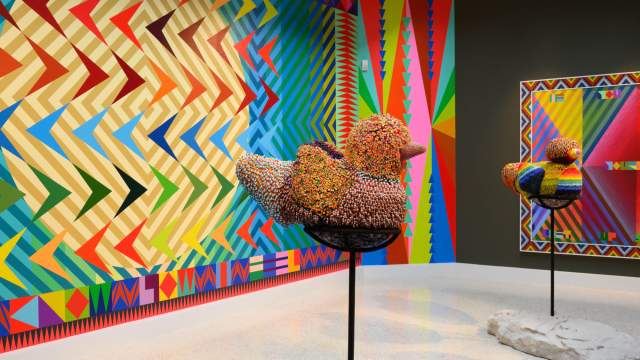
The Venice Biennale is “the art world’s great beano”, said Laura Freeman in The Times. Every other year, artists, collectors, curators and assorted hangers-on from all over fly into the Italian city to see what is widely considered to be the planet’s most prestigious exhibition of contemporary art.
This latest iteration of the biennale – its 60th – is especially “vast”. As ever, the event involves a “massive” central exhibition: this time entitled “Foreigners Everywhere”, it features the work of some 330 different artists – a record, even by biennale standards.
Outside the main event, there are no fewer than 90 national pavilions scattered across town, in which countries compete for the coveted Golden Lion award; this year, the prize was won by the indigenous Australian artist Archie Moore.
In addition, there are countless satellite events and displays spread city-wide – from a Willem de Kooning retrospective to an AI-assisted immersive experience in which “jellyfish pulse across an asteroid belt”. Exhibits range from the good to the bad to the downright “bizarre” – but whatever you’re looking at, you can guarantee that “there’s always something better, barmier and more beautiful round the corner”.
The mood of this biennale is “solemn, concerned, occasionally didactic”, said Laura Cumming in The Observer. The preoccupations of the artists – “colonialism, migration, queer and indigenous rights, climate crisis” – will surprise nobody, and geopolitics are inescapable: Russia is absent and Ruth Patir, Israel’s artist, has chosen to keep her exhibition closed until “a ceasefire and hostage release agreement is reached”.
The national pavilions are a mixed bag. John Akomfrah, representing Britain, has produced an epic show consisting of eight films playing out on multiple screens. Touching on everything from the English landscape to immigration to Chinese poetry and African history, it is “wonderfully absorbing” in parts – but with a total running time of five hours, it is simply too much to take in.
Spare yourself and head to Poland’s pavilion, where a group of Ukrainian artists have created a film installation that sees survivors of Russian missile strikes attempt to replicate the noise of approaching projectiles. Better still is Bulgaria’s offering, in which “profoundly moving revelations about the country’s Communist-era history” are recounted over speakers hidden within items of everyday furniture.
Many of the Western world’s pavilions are “lacklustre and one dimensional”, said Jackie Wullschläger in the Financial Times. The US’s Jeffrey Gibson, for instance, fields a disappointing set of “gaudy bead-encrusted sculptures alluding to Native American traditions”.
The real revelation at this year’s biennale, however, is the main exhibition – a show “so traditional that it is radical”. The usual installations, films and digital displays are nowhere to be seen: instead, it offers an array of “unabashedly rapturous paintings and harmonious, formally satisfying sculptures”. There are works spanning 100 years by artists from Africa, Asia, the Middle East and South America.
It amounts to a history of modernism in the Global South, with works by Argentine cubists, Iraqi modernists and Lebanese abstract artists. Highlights include the Pakistani-American artist Salman Toor’s beautiful “Night Grove”, with figures “bathed in otherworldly green luminosity”; and Bárbara Sánchez-Kane’s “Prêt-à Patria”, an absurdist sculpture of goose-stepping Mexican soldiers. The exhibition is a wonderful centrepiece to a largely impressive biennale.
Various locations, Venice, Italy (labiennale.org). Until 24 November
Central exhibition features the work of some 330 artists





